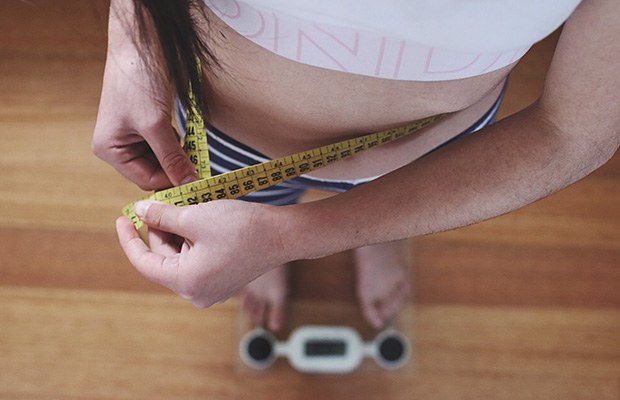When it comes to people’s top goals for improving body composition, fat loss often takes the cake. But we can’t talk about how to lower body fat percentage without touching on how to drop pounds in general. That’s because you can’t necessarily target fat loss in one specific area — say, just your arms or belly. You have to work to reduce fat all over. And that comes down to one main principle: calorie deficiency.
“To lose fat, you have to create a calorie deficit,” says Jamie Costello, CPT, director of fitness at Pritikin Longevity + Spa, a top-rated weight loss resort in Miami. In other words, you have to burn more calories than you consume. While of course diet is involved in that, Costello also emphasizes moving more — and not just in a sweat session, but also those hours between your morning alarm and your bedtime.
“If people are sedentary all day — and just work out for an hour every other day — that might improve cardio, heart health, bone strength and lower the risk of injury. But when it comes to weight loss, the amount of effort [you’d need in that hour] is pretty big,” Costello explains.
So, what should you be doing in those daily hours from dawn to dusk to help you drop that body fat percentage? We scoured the science and spoke to the experts. Here, four fitness must-dos to see results, plus other can’t-miss tips for finding success.
4 Strategies for Reducing Body Fat Percentage
1. Start Steppin’
It may seem small, familiar and just a little too easy, but it’ll make a difference: Get on your feet more often. As Costello puts it, it’s difficult to burn enough excess calories in an hour-long sweat session alone. But frequently taking breaks from your seat? That could actually make or break your daily deficit. In fact, a recent study found that simply standing rather than sitting for six hours a day could help a 140-pound person burn more than 50 extra calories in 24 hours. And that doesn’t involve any movement, just static standing. Imagine the calorie-crushing possibilities if you took brisk walks on the daily.
2. HIIT It Hard
Besides taking more moments to stand up, doing a more efficient workout means you’ll blast more calories and burn more fat. For that, you’ll want to turn to interval workouts, says Costello.
Metabolic conditioning (aka metcon) workouts place a high-demand on the body by testing its different energy systems. “Once you influence your metabolic burn rate, it stays up even during rest intervals. That gives you a much more efficient fuel burn, without feeling like you overdid it,” says Costello. He suggests sticking with metcon workouts of about 30 minutes and HIIT workouts (in which you work at an even higher intensity) for about 15 minutes. Aim to do these every other day, or take two to three days of rest between each, so your body can properly recover, Costello says.
“As you get in better shape, you’ll see that you burn more calories week after week, because you don’t get as exhausted,” Costello explains. That’ll also help you reach the caloric deficit you need for weight and fat loss.
3. Add Some Resistance
Beyond sweat-inducing intervals, another way to increase your fat-burning and muscle-building potential is resistance training. “Strength training is indispensable, because it’s the only thing that preserves muscle tissue over time,” says Brad Schoenfeld, PhD, CSCS, assistant professor of exercise science at Lehman College in Bronx, NY. “Cardio can burn more calories, but it doesn’t do much to prevent muscle loss.” And you’ll want more muscle to burn more daily calories.
Science backs up this need to lift weights for weight loss. A recent study involving about 250 individuals in their 60s pitted cardio workouts against strength sessions. The researchers found that while you need both, resistance work wins out in terms of losing fat without losing muscle.
“If you want to preserve muscle during weight loss, you need to stimulate it with a progressive resistance training program,” says Kristen Beavers, assistant professor of health and exercise science at Wake Forest University and lead author on the study. (She notes these results most likely apply to younger people, too.) So if you want to build muscle that staves off weight loss, you can’t turn to walking or running alone.
Another benefit of strength training: It preps your muscles to push even harder during tough interval sessions, says Costello. “When you improve your muscles’ metabolic conditioning — so think of building lean muscles — you’re building the capacity to go faster,” he says. While lots of people place emphasis on how this helps you burn more calories at rest, Costello says it also lets you push yourself in your next workout. Aka the more you strength train, the harder you work in your next workout, and the more calories you burn overall. Hello, calorie deficit, weight loss and body fat reduction.
To effectively implement strength training into your schedule, Shoenfeld suggests continuously changing up your routine and adding more resistance to see weight loss and muscle gain. “You have to lift at a high level of effort and challenge your muscles on a consistent basis,” he says. Shoenfeld suggests focusing on total-body, compound movements that work multiple muscles at once, which will also up the calorie burn. Aim for at least three days a week for these workouts, he says. As for choosing a weight (if you’re upping it from bodyweight), mimic the protocol of the Wake Forest study, opting for 70% of your one-rep maximum and readjusting as you get stronger.
4. Focus on Burning Calories, Not Necessarily Fat
No matter which workouts you choose, keep in mind, if you want to burn fat, you don’t necessarily need to work in the fat-burning energy system. If you’ve ever stepped on a cardio machine (an elliptical, in particular), you may have noticed the meter on the dashboard illustrating your training zone (say, warm-up, fat-burn, cardio and peak heart rate). Fat-burn is on the lower end of the effort scale — we burn fat even while sleeping, Costello explains — therefore, it’s not necessarily the ideal training zone for fat loss.
“People mistakenly think that if their goal is to lose fat, then they should train in this fat-burning zone,” Costello says. “The problem is, you’re still not burning very much. It’s your total caloric expenditure that’s most important — not the type of fuel source you’re using at any given time.” That means, if you opt for high-intensity interval training level, then you’re burning more energy overall — even if less of that energy comes from fat as the fuel.
Don’t Forget What’s on Your Plate
As mentioned earlier, to lose fat (and weight) you need a calorie deficiency — therefore, it’s also time to address your diet habits.
“The least important thing you should be considering [in terms of exercise for fat loss] is where the fuel source is coming from. But the opposite is true when you’re eating — you need to think about where your calories are coming from,” Costello says. Instead of strict calorie counting, Costello recommends focusing on less calorie-dense foods, meaning those that will fill you up thanks to fiber and water, more so than empty calories. You probably guessed this means lots of veggies — as in at least half your plate — plus, fruits and legumes.
Schoenfeld also mentions the importance of protein. “Make sure you have adequate protein intake, as it’s well documented that it helps maintain lean body mass,” he explains. The recommended dietary allowance for protein is about 0.8 grams per kilogram bodyweight or about 46 grams for an average woman, though if you’re super active you probably need more.
Another strategy for success: Avoid diets that are too restrictive, as you won’t stick with it long enough to see results. Shoenfeld suggests sticking with the 80/20 rule and learning your food habits, so you can avoid overeating before it starts.
Sleep Also Plays a Role
Finally, to lose fat, you have to focus on catching those zzz’s. Costello says that without recovering from exercise properly (translation: getting ample sleep!), it’s tough to see results. “Sleep is a huge component to reset and reenergize so you can burn more calories the next day,” he says. “Also, recovery between workouts [is crucial]. Choose just three to four workouts a week where you really push yourself. Then have the medium-effort workouts, too. That recovery will help you push harder through the tough ones.”
The Big Picture: Small Steps, Big Results
You probably know this at heart, but it’s worth mentioning. Lowering your body fat percentage doesn’t happen overnight. Or even over seven nights. Costello says, on average, losing about one to two percent body fat a month is a realistic goal. (Here are a few ways to measure your progress.) Don’t get discouraged if you’re not seeing results right away. Continue with your interval and strength training workouts, and focus on eating a clean diet and getting ample rest in between. As they say, all good things come to those who wait…and hustle to the gym.









